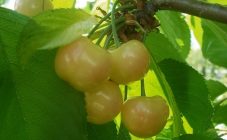Content:
Back in the middle of the last century, cherries were grown only in the southern regions of the Soviet Union. Its varieties had low resistance to frost, so in the more northern regions they froze and died. But thanks to the efforts of domestic breeders, a large number of frost-resistant varieties were bred. They were zoned for cultivation in the central regions of Russia, the middle lane, the Moscow region. One of these varieties is the Lyubimitsa Astakhova sweet cherry, a description of the variety and its characteristics will be presented below.
General information about culture
This cherry was bred in the city of Bryansk at the local research institute of lupine, where specialists have created many new varieties of fruit trees (including stone fruit). The author and originator of cherry Pamyat Astakhova is the breeder Kanshina M.V. She was based on the varieties grown in the Voronezh and Leningrad regions. This variety was named after the spouse of the creator of this cherry.
The variety has passed tests, was entered in the State Register in 2011 and zoned for cultivation in the Central region and other regions of our country with a similar climate.
Characteristics and features of the variety
The shoots of this tree have an average vigor, the height of the cherry in Memory of Astakhov can reach 3.5-4 m. The crown is not too thickened, has an oval, rounded or rather spreading shape. The bark of the trunk and skeletal branches is prone to peeling, has a dark gray color. Usually the formation of this culture is carried out in tiers.
The foliage is medium in size and elliptical in shape. The ends are elongated and slightly pointed, leaves of a matte emerald hue. Bouquet branches form buds, and then ovaries form. Flowers are collected in inflorescences (2-3 pieces each). They are saucer-shaped, and the cups are goblet. The color of the skin and pulp of ripe fruits is dark ruby. The berries have a regular oval shape, firm, with a slight sheen. Their weight can be up to 7.5-8 g. Ripe, fleshy, dense pulp is easily separated from small-sized seeds.
Gardeners note the good taste of ripe berries, their tasting score is 4.8 points. The yield of sweet cherries in Astakhov's memory is not too high and amounts to 9-11 kg per tree.
When fresh, the harvested crop is poorly stored; in the fresh air, the fruits begin to rot within a day after harvest. But in the refrigerator, in a box with fruit, cherries can be stored for up to a week. Do not store these berries in plastic bags. It is also not recommended to put washed berries in the refrigerator - this leads to their rotting.
The harvested crop is used for fresh food, the berries are dried, canned and frozen, and juice is prepared. The taste of sweet cherries does not change much after freezing.
This cherry is highly resistant to moniliosis and coccomycosis, as well as some other diseases that damage stone fruit crops.
The frost resistance of the variety is much higher than average, so it can be grown in the conditions of the Urals and some Siberian regions. In the north of our country, Astakhov's pet is grown on low rootstocks, so that it is easier to cover these fruit trees before the onset of winter.
The lower branches are parallel to the soil. The first crop of cherries Lyubimitsa Astakhova gives in 5 seasons after planting seedlings in a permanent place. The variety is partially self-fertile, so it is better to plant pollinator trees nearby (the distance between them should be no more than 6.5 m). In this case, the yield of sweet cherries of this variety will increase significantly.
It is best to plant several varieties of cherries nearby that bloom at the same time.
The best pollinators for Pet Astakhov:
- Iput;
- Ostuzhenka;
- Jealous;
- Red hill;
- Kid;
- Large-fruited.
Often summer residents, who have a small garden plot, simply graft cuttings from pollinating trees onto this varietal tree.
Agrotechnics
Planting young trees is required correctly. Ideally, if the seedling was purchased with a closed root system - in this case, the acclimatization of the culture will take place in a short time.
The planting hole is prepared a couple of weeks before the planned planting of the tree. The size of the pit is up to 1 m in diameter, and the depth is 0.5 m.
The top fertile soil layer is laid out on one side of the pit, and the rest of the soil is laid on the other side. Fertile soil is spread on the bottom with a hill. A stake is dug in next to it, to which the seedling will be tied after planting. The seedling is placed on a mound, the root system is spread along its slopes, the tree is tied to a peg and covered with the remaining soil. From above, the trunk circle is carefully tamped and at least 20-30 liters of water are introduced under each tree.
The root collar is not buried in the ground, it should rise 4-5 cm above ground level.
To get good yields of sweet cherry, you need to know what areas this crop can "love". The place where cherries are grown should be well lit and protected from strong gusts of wind. The soil should be loose, absorbent well. The groundwater level should be at a distance of 1.5-2 m from the surface of the earth, since excessive soil moisture is detrimental to this type of stone fruit trees.
The acidity of the soil should be neutral or slightly alkaline. Lime or dolomite flour must be added to an overly acidic soil in the fall. Also, under the autumn digging, organic matter is necessarily introduced - well-rotted compost or humus.
It is better to propagate cherries Astakhov's favorite by grafting cuttings to the stock. In the northern regions, undersized rootstocks are selected, which are easier to cover before the onset of frost.
Further care includes:
- regular watering;
- loosening the trunk circle;
- mulching;
- regular removal of weeds;
- applying dressings several times per season;
- formative and sanitary pruning.
In addition, a number of agrotechnical measures should be taken to care for this fruit crop in the fall in order to prepare it for the coming winter: add nutrients in time and carry out moisture-charging irrigation, which will help the root system to absorb moisture and prepare for the cold weather.
Sanitary and formative pruning is best done in the spring before the buds swell, and in the fall, you can carry out a rejuvenation procedure, as well as remove damaged or dry and weak branches.
Advantages and disadvantages of the variety
The main advantages of this cherry variety:
- frost resistance;
- excellent taste;
- unpretentiousness, no special care is required;
- resistance to major diseases and pests is above average.
The main disadvantages of Astakhov's Favorite:
- in the absence of a number of pollinating varieties, the crop yield drops sharply;
- the vulnerability of trees in the first years to severe frosts, therefore, they need to be covered for the first years before the onset of winter.
This variety has a large number of positive qualities, therefore, such a cherry can be grown even by novice gardeners.
















